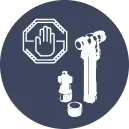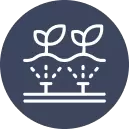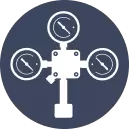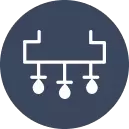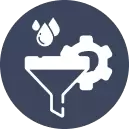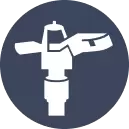Drip irrigation is a method of directly watering plants at the roots. Smart irrigation is an efficient way to water crops, gardens and landscapes. It conserves water, reduces waste, and increases plant hygienics. Drip irrigation is used around the world by farmers, gardeners, and landscape professionals.
How Drip Irrigation Works
Different parts of drip irrigation system work together so that water can reach everywhere.
- Mainlines and Lateral Lines: These are tubes that transport water from the source to various parts of the field or garden.
- Emitters: Emitters control the flow of water and are small devices. They make sure that each plants receives proper amount of water.
- Filters and Regulators: These components help keep the tubes from becoming clogged, water pressure remains consistent.
- Drip Tape or Microtubing: These are flexible tube lines that are installed directly near the plant roots to deliver water.
It works by passing water through a labyrinth of tubes and emitters. That means the water goes exactly where it needs to be, conserving water and making plants healthier.
Benefits of Drip Irrigation
The advantages of using drip irrigation for the plants and environment.
- Efficient Use of Water: In drip Irrigation, the water supply is direct to the roots. That means there’s less water that is lost to evaporation or runoff.
- Conserving Every Drop: The system helps make the best use of every drop of water in regions where water is in short supply.
- Consistent Water Supply: Plants get a constant water supply, which makes them stronger and healthier.
- Deeper Root Development: Allowing a steady water supply promotes the plants to grow deeper roots. This makes them more resilient to drought and pests.
- Less Water for Weeds: The only area getting water is around the plant roots, meaning weeds nearby have less opportunity to thrive.
- Preventing Soil Loss: The sediment in the controlled water helps to prevent erosion, protecting the land.
- Lower Water Bills: Efficient use of water saves money on water bill.
- Less Need for Chemicals: Healthy plants require less intervention by fertilizers, pesticides and other chemicals.
- Long-Term Savings: While setup costs are higher initially, drip irrigation yields higher crop yields and cost-effective maintenance.
Where Drip Irrigation is Used
Drip irrigation can be used in many different environments. It provides nourishment for large farms and small gardens, in greenhouses and urban areas.
- Large Farms: Farmers water fields and orchards with drip irrigation. This way to water ensures that every plant receives the appropriate amount of water, resulting in better crop quality and increased quantity of food.
- Gardens and Horticultural Areas: Gardeners and nursery operators use drip systems to ensure that delicate plants are kept constantly moist without oversaturation and the ever-popular mulching also help.
- Public Gardens and Parks: Landscape irrigators in parks & golf courses used drip irrigation. This system contributes to preserving green spaces and saving water.
- Urban Landscaping: Drip irrigation is popular for landscaping in yard space and with public landscaping in urban areas to ensure proper water utilization and drought conditions.
- Controlled Environments: Greenhouses and nurseries require highly accurate water management. For high-value crops, growing plants should be watered consistently, so drip irrigation will be suitable.
- Small Spaces: Urban farmers employ drip systems on balconies, rooftops and tiny plots. Letting them grow their own fruits and vegetables, all while using little to no water.
Technical Considerations for Setting Up Drip Irrigation
The right way to set up a drip irrigation system is easy. It consists of planning, picking the correct components, setup, and routine maintenance.
1. Planning the Layout
In step one, sketch a garden or field plan. This assists in determining the locations for the mains, laterals, and emitters. With a good plan, all plants will be watered equally, and there will be not much loss of water.
2. Choosing the Right Components
Choose quality tubes, emitters, and filters suited to your local climate. Every garden and farm sets different needs. Choosing the best of the parts will help in getting it to work the way you want.
3. Installation and Maintenance
Putting in a drip irrigation system is fairly simple. During installation, the manufacturer’s guidelines should be followed closely. Maintenance involves checking for clogged emitters, inspecting tubes for damage and making sure that water pressure is steady. Global style regular maintenance keeps the system running smoothly.
4. Adding Smart Features
Newer drip systems come equipped with sensors and timers that adjust the watering schedule automatically. These intelligent systems save more water by adjusting to fluctuations in weather and soil moisture. Smart technology is applied in the system to increase the system efficiency and minimize the requirement of continuous manual adjustments.
Environmental and Economic Impact
Drip irrigation is not just good for the plants, but it is also good for the environment and the economy.
- Environmental Benefits: Less waste means healthier soil and the more efficient use of water with drip irrigation. Furthermore, this method is eco-friendly as it minimizes the use of chemicals.
- Support for Sustainable Practices: Because drip irrigation is a more sustainable technique it lends itself very well to modern agricultural practices aimed towards resource management and preservation of natural ecosystems.
- Saving Energy: Because the water travels straight to the roots, it requires fewer pumps and sprinklers that consume energy, saving on the overall energy consumption of the system.
- Reduced Carbon Footprint: Using less power also means that the system emits less greenhouse gases, aiding in a healthier world.
- Resilience in Tough Times: Drip irrigation helps sustain plants in areas facing unpredictable weather or drought. Its low water consumption helps ensure its viability during climate change.
- Supporting Food Security: By having more consistent crop yields, drip irrigation helps ensure that in even dire weather conditions, there is enough food.
Why Growcycle is a Trusted Choice
Growcycle provides reliable and dependable high-quality drip irrigation supplies. With knowledge of countless industry specifics and a passion for customer service, they provide automatic issues that many wear away.
Quality and Durability
The drip irrigation parts are made from strong, durable materials. This can identify whether the systems work nicely underneath different climate situations. Whether have a small garden or a large farm, their products are designed to last, and are a great investment.
Expert Support and Custom Solutions
They provide guidance and support to help clients select the right setup. They have advice on everything from the planning stages, through the installation and aftercare. They use it to customize the drip irrigation system according to the unique needs so that each customer receives the most suitable solution for their condition.
A Commitment to Innovation
These systems are equipped with the latest and greatest technology including smart controllers and sensors to increase the efficiency of our systems. It saves water apart from efficiency, drip irrigation uses far less water than other irrigation methods.
Future Trends in Drip Irrigation
Drip irrigation is a constantly changing field. And new trends are continually making it even better and easier to use.
- Smart Watering: Internet of things (IoT) technology will be employed in future systems to monitor soil moisture, weather, and plant requirements. This helps the system adapt automatically, conservatively watering even more.
- Real-Time Decisions: With more data available, drip irrigation systems will be able to make smarter decisions about when and how much water to apply. That means healthier crops and less wasted resource.
- Eco-Friendly Components: There is a growing trend to use materials that are better for the environment when making drip irrigation systems. This supports a greener approach to farming.
- Combining Techniques: Upcoming irrigation systems may blend drip watering with different supportable practices, for example, rainwater gathering and sun based fueled pumps to build a complete and green water organization system.
Conclusion
Drip irrigation is a new, easy and efficient way to provide water for crops. It helps conserve water, promotes healthier plants and, with the initial investment, pays off over time. It consists of a network of tubes that lead to emitters, which dispense the water directly to the roots. This targeted method makes sure that water is used where it makes the most sense.
In some cases, drip irrigation may be used in a wide variety of settings such as large farms, greenhouses, and small urban gardens. It contributes to both the growth of healthy crops and the conservation of water and protection of the environment. Drip irrigation systems are becoming increasingly efficient and easier to manage, thanks to smart technology.
Growcycle is a trusted name in drip irrigation solutions. They have quality products, customer-focused support, and the leading-edge technology that different users require. When they choose drip irrigation, they promote sustainable farming practices, reduce energy use and contribute to mitigate the consequences of climate change.
